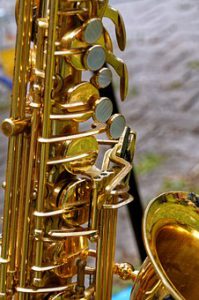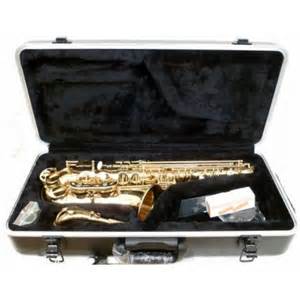From the point of view of a former repair technician, here’s what I know that will be helpful for the parent/supplier of the saxophone beginner.
To begin with, a new saxophone (sax) student will need a reliable instrument. This is sort of a  quandary, as the sax has all the bad characteristics of both woodwind and brass instruments.
quandary, as the sax has all the bad characteristics of both woodwind and brass instruments.
The body and neck are made of brass, which can be dented, scratched, bent, punctured, scraped, and torn. The brass of the body (and sometimes the keys as well) is polished to a mirror finish at the factory, where it is then lacquered.
Lacquer is a form of clear paint. Those of you who have worked with polished brass in other areas (plumbing fixtures, door knobs, boating applications), know that the instant lacquered brass is scratched, it begins to oxidize and turn brown.
So this is what you have to look forward to, as the beginner begins to understand the actual size of this noisy thing hanging from her neck, and as she learns not to run it into things. It’s going to get beat up, scratched, and dented, and the fallout from that is that the instrument will start to look worn, as well as not work from being out of adjustment. It’s going to be OK, nobody has stopped breathing yet!
The other disadvantage of saxes is that they have this really complex (read: fragile) key mechanism, which is designed to transfer the motion of the fingers to a pad/tone-hole combination, often some distance away from that finger. The mechanism is brass (read: soft metal), which as we’ve just learned, can be dented, scratched, bent, punctured, scraped, and torn.
 All this to say that a beginner sax should be as well-made as you can afford, since it will be subjected to a lot of (unintended, normally) abuse.
All this to say that a beginner sax should be as well-made as you can afford, since it will be subjected to a lot of (unintended, normally) abuse.
One of the best sources of advice on brands and models can be had from your area middle school, or maybe high school, band director. This person has likely had years of teaching experience, including the inevitable collapse of a saxophone moments before an important concert performance. They likely remember the brand of the offending instrument.
Another good source on brands and models would be the independent repair technician in your area. An experienced technician will have seen thousands of saxophones during their career, and can certainly advise on the best varieties. Members of NAPBIRT, the National Association of Professional Band Instrument Repair Technicians, are dedicated to continuing education in their craft, and can be found on their site, here.
This ‘good as you can afford’ saxophone will need to have a reasonable case. The case really has 2  functions – to protect the instrument from impact, and to protect it from the weather. Anything else it does (storage, carry comfort, style) is entirely secondary. Most instruments (new purchase, rental, or used sale) will have a case, and if it’s a used instrument, be sure to check that the handle is secure, and that the latches and hinges work well.
functions – to protect the instrument from impact, and to protect it from the weather. Anything else it does (storage, carry comfort, style) is entirely secondary. Most instruments (new purchase, rental, or used sale) will have a case, and if it’s a used instrument, be sure to check that the handle is secure, and that the latches and hinges work well.
We’ve already established the idea that the instrument is fragile, now we come to the idea that weather can be a problem.
Like all other woodwind instruments (clarinets, flutes, oboes, bassoons, etc.) the saxophone makes different notes by opening/closing holes in the brass body. The mechanism that makes that work is finger pressure on a round ‘key’ that has a leather-covered ‘pad’ attached. The leather pad is pressed onto the surface of the ‘tone hole’, and if it seals, the sound comes out the next hole down the horn that’s not sealed.
 Weather affects the leather pads and the glue that holds them in the pad cup. Water, in the form of rain, condensation, or saliva, can affect the leather surface, putting it at risk of not sealing, and thereby making the instrument squeal or otherwise sound badly.
Weather affects the leather pads and the glue that holds them in the pad cup. Water, in the form of rain, condensation, or saliva, can affect the leather surface, putting it at risk of not sealing, and thereby making the instrument squeal or otherwise sound badly.
Cold can also affect the pads by weakening the glue that holds the pads in the key cups, sometimes to the point that the pads will fall out, requiring replacement (read: expensive). Note to parents: do not allow the sax to stay in the car trunk overnight in the winter!
Heat has a similar affect. The glue holding the pads in place is also sensitive to heat, so the same warnings apply – do not allow the instrument to stay in the hot car for any length of time, or the pads will shift or fall out, requiring replacement (read: expensive!)
Among all the other things a new player will require to be successful is a passing knowledge of common maintenance. Most beginning band programs require the new student to have a maintenance kit (sometimes called a ‘care kit’) specific to their instrument. The saxophone kit should have at minimum a mouthpiece brush, a drop swab, a neck brush, cork grease, and a manual.
Learning to use these tools can save hundred of dollars in repairs, and sometimes in medical bills as well. For instance, many common respiratory infections can be avoided if the student remembers to clean the mouthpiece regularly, with the mouthpiece brush, and warm (not hot!) soapy water.
Many of these bits of useful information can be ‘caught, rather than taught’ when the beginner is taking  private lessons. I’m a big advocate of private lessons.
private lessons. I’m a big advocate of private lessons.
Think for a moment about the school band situation, at least in the US. The band period is about 50 minutes long, there’s about 50 kids in the room, how much personal attention is each child going to get? Not much. Particularly in the case of a beginner, some very clear, intense, personal attention is going to hugely increase their chances for success.
So the minimal skills that a beginner needs at the ready in order to participate in private lessons, and in a band situation, are:
- how to get the various parts out of the case
- how to install the reed on the mouthpiece
- how to install the mouthpiece on the neck
- how to attach and adjust the neck strap
- how to attach the neck to the body
- how to hear and pay attention to direction from the private teacher or band director
- how to disassemble the instrument
- how to get the water out of the neck and body
- how to safely get all the parts back in the case
Here’s a video with some very clear information on assembly, disassembly, and care of the saxophone.
With a very solid foundation like this, and with the support and love available in the home, the beginning sax student has every reason to expect success!

– as always, we welcome your comments!

Hi, Peter, and thanks for stopping by! It’s rare to read someone who has the insight you have about time, commitment, and the parents’ roles in extra-curricular education. I appreciate your thoughtful reading of the post. Best wishes for your success!
Hi thanks for the article. Playing an instrument takes a lot of time and I believe that parents should get involved if their children want to learn how to play one. With that being said I believe articles like this one are a great way for parents to learn more about the instrument their child wants to play so that they can have an idea of the dedication they have to put towards their child’s goal.
Hi, Daniel, and thanks for your interest! I’m using my years of experience in the musical instrument industry to try to help people avoid the common pitfalls. Sometimes, it is cheaper in the long run to buy the more expensive beginner (or used) saxophone, especially when the student’s level of commitment is unknown, since a higher quality instrument will hold some level of resale value. The other option is to rent one, especially when the rental contract includes a ‘3-month minimum’ or similar language, giving the renter an easy option if the student decides they’d like choir, or wood shop, better. Be careful about the rental contract, some of them are actually ‘rent-to-own’, where you end up paying retail plus 100% or so over 36 months, with no option to take it back before the term is up. Thanks for stopping by!
Hi, Marsha, and thanks for your interest! it’s so important that beginners and others have some knowledge about regular maintenance on such a fragile and expensive instrument as the saxophone. Your son’s tenor is even more exposed because of its bigger size. I’m glad the information will be useful, and I wish you both a positive experience!
This was very informative. Thank you for sharing this information. My son just started playing a tenor sax this summer so the information was very relevant to me. I definitely appreciate the tips about weather. He has joined the marching band so will be outside with his instrument a lot. The video is good and will provide good instruction as I work with my son to take care of his instrument.
Hey Barry, thanks for making this subject more clear in terms of what kinds of cost and work goes into owning a saxophone (or any instrument, for that matter). It seems to me, it’s like buying a puppy or a car… you have to remember all the hidden costs and maintenance down the road.
You mentioned that it would be cheaper for the parent just to buy the more expensive one that will require less cost in the future. I agree with you, however, in the case of a student that isn’t sure whether they want to play the instrument, do you think it would make sense to go ahead and buy the cheap one and then upgrade to a better instrument once the student has decided to stay with it?
Hi, Angela, and thanks for stopping by! I’ll definitely be doing an article on flutes very soon – my experience is similar to yours; as a technician, it was always difficult trying to tell a parent of a beginner that the ‘bargain’ they got will cost more to make play than a new, better made instrument! Frustration all around. I’m praying that more information will be better for everyone. Thanks for the kind words!
This is an awesome summary! As a flute teacher I always cringe when my new students show up with a flute that they got a “good deal” on . . . $50 at a garage sale last week! There is certainly nothing more frustrating for a new student (and their teacher!) than trying to get sound out of an instrument that I would even struggle to play. Will you be posting anything on flutes? I’ll be visiting back here again!